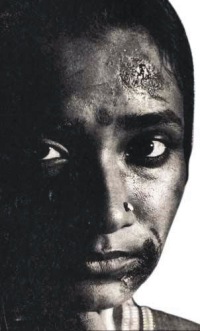Domestic
Violence: where is the end?
Kathita
Rahman
Violence against
women is a growing problem in all societies and recognised as one of
the major infringements of human rights. Violence is a major factor
in the marginalisation of women in economic, political, and social life,
and presents a significant health risk for women. It takes many forms,
and occurs in all settings: at work, in the home, in the streets and
the community at large.
 Domestic violence in particular
is the epitome of unequal power relationships between women and men.
Violence against women, particularly domestic violence, is a significant
and widespread problem that can be found in a wide variety of settings.
The review of a selected number of well-designed, population-based surveys
indicate that between 20% to over 50% of women report having been abused
physically by an intimate male partner at least once in their lives
(WHO, 1997).
Domestic violence in particular
is the epitome of unequal power relationships between women and men.
Violence against women, particularly domestic violence, is a significant
and widespread problem that can be found in a wide variety of settings.
The review of a selected number of well-designed, population-based surveys
indicate that between 20% to over 50% of women report having been abused
physically by an intimate male partner at least once in their lives
(WHO, 1997).
Domestic violence
happens in Bangladesh may be in different ways wife-beating, and batteringis
almost always accompanied by psychological abuse and in one-quarter
to one-half of cases by forced sex as well. The majority of women who
are abused by their partners are abused many times. In fact, an atmosphere
of terror often permeates abusive relationships. But whatever the form
of violence it affects all spheres of women's lives: their autonomy,
their productivity, their capacity to care for themselves and their
children, and their quality of life. The fact of its consequences is
far reaching. It impacts on all aspects of women's lives, their health
and that of their children, and also on broader society. In addition,
there are many ways in which violence perpetuates itself. Violence is
sustained by inequality and in turn perpetuates inequality. For example,
domestic violence is associated with poverty, but it also perpetuates
poverty by, for example, reducing women's opportunities for work outside
the home, their mobility and access to information and children's schooling.
In addition to the direct impact of violence on the woman and her life,
several studies indicate that domestic violence against women also impacts
on their children, whether they only witness the domestic violence or
are themselves abused. These consequences include behavioural problems,
which are often associated with child management problems, school problems,
and lack of positive peer relations (Jaffe et al, 1990).
More specifically
to say violence is not only a health issue; it is an infringement of
women's human rights, for example, the right to bodily integrity. It
also impinges on their ability to exercise other human rights, such
as the right to the highest attainable standards of health, and their
sexual and reproductive rights. Violence is reinforced and condoned
by the many forms of discrimination which women experience in society.
Many countries still need to ratify human rights conventions such as
the Convention on the Elimination of All Forms of Discrimination Against
Women (CEDAW), which provides the framework for revising laws that will
begin to support the redress of existing inequalities between women
and men, and problems like violence against women.
Inadequate legal
structures in our country effectively condone violence against women.
But it is also true that in countries where adequate laws are in place,
violence against women is often considered socially acceptable, and
these laws are rarely enforced. It is important to reduce violence against
women include efforts to address the immediacy of a violent situation
through the provision of services to victims, such as shelters and counselling,
and long-term strategies to address the root causes of the problem.
Writer
is a staff of UNDP